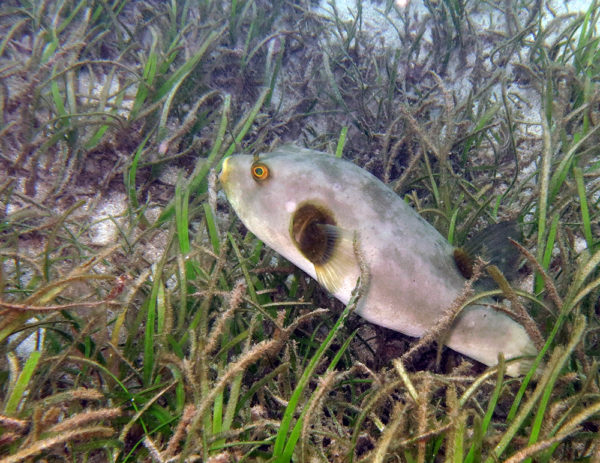A major carbon sink underwater, seagrass ecosystems need to be understood better if they are to be conserved.

Tape seagrass at Henry Lawrence
Recent dire warnings from the World Meteorological Organisation say that impacts of global warming are accelerating and driving global temperatures to dangerous levels. At around the same time, the International Energy Agency also reported that carbon emissions in 2018 were up by 1.7% due to growth in energy use.
The carbon levels which were 357 ppm in 1993 are now at 405.5 ppm. Temperatures have risen one degree over what prevailed before the Industrial Revolution, making it difficult to keep it within a 1.5 deg rise, the threshold beyond which irreversible climate change has been predicted.
The carbon dioxide and other greenhouse gas emissions that remain in the atmosphere absorb and trap the heat, raising temperatures. Some of the gases also get absorbed by the oceans and seas, increasing their acidification. Within the waters, some of these gases are absorbed by the vegetation. In terms of amounts taken in, the seagrass probably stands tallest.

A pufferfish taking shelter in a seagrass meadow
Grass as long as 150 cms and 2 cms wide waving gently on the ocean floor, providing a nursery of sorts for baby fish, food for many turtles and gulping down carbon dioxide from the acidic water. They also provide a home and feeding area for more than 1,000 species of fish, including fishes that humans eat. That is what the Tape seagrass ecosystem manages to accomplish, and the list of services extends further.
In Indian waters, it has the longest leaves. The edges of the leaves are slightly rolled and the leaves have air channels. In addition, they have thick rhizomes (underground stems) that are densely covered with the stiff black fibrous strands, which are the remains of old leaves. The rhizomes have many cord-like, hairless roots. The roots also have wide air-channels.
The many services
They are known as primary producers because they make their own food through photosynthesis. Being food for marine life they play an important role in the food web. Enhalus seagrass is believed to be important food for green turtle and many herbivore fish. Traditional people living on the coasts of Australia and the Philippines eat the fruits of seagrass. There are a few anecdotal reports of fishermen eating this seagrass. Eaten raw, they are said to taste like water chestnuts. A durable fibre useful for fishing nets is also made from it.

A rocky outcrop at Henry Lawrence island
This seagrass can also hold a lot of underwater soil (known as sediment) together, thus helping to protect the coasts from the impacts of storms and large waves, by preventing coastal erosion.
On the seagrass blade grows a wide variety of tiny encrusting animals like green gum drop ascidians and seagrass hydroids and egg capsules. Tiny algae often grow on the leaves of this seagrass, providing food for grazing creatures. The mat of rhizomes also provides shelter for many small animals.
In terms of carbon dioxide taken in from the seawater, they are next only to the tundra in ranking as an efficient carbon sink. Estimates suggest that seagrass meadows can bury carbon in oxygen-depleted underwater sediments 40 times faster than tropical forests bury it in soil. The removal of carbon dioxide from the water helps to keep the pH of the water stable. A stable pH is important for animals that have shells or external skeletons, such as corals and molluscs (clams, oysters, etc) which can be corroded by acidic water.
Threats
Despite all the ecosystem services they render, seagrass meadows are largely neglected. Fertiliser pollutants, sewage, sand mining, trawl fishing have been wreaking damage on the seagrass ecosystem and in many parts of the world a population decline has been recorded across its range.
It is in this context and the urgency of the climate change dialogue that attempts are being made the world over to plant seagrass on the seafloor. The grass is not a weed but sprouts flowers and fruits which eventually release seeds that float for some time and sink later to germinate.

Fruit of seagrass
But more studies are needed to on the phenology, ecology, and biology on often neglected seagrass ecosystem if we are to undertake its conservation and growth. That is where the recent study by researchers including our scientist Vardhan Patankar provides an important baseline.
This is the first observation of this tall seagrass’ flowering and fruiting, which has not been documented so far. The observations establish an important reproductive stage in the life cycle of the species and open avenues for further seagrass research.
The Andaman and Nicobar archipalego has 11 seagrass species. The present work will not only provide new information on the phenology, ecology, and biology of E. acoroides and other seagrass species but also provide empirical and technical support for seagrass meadow conservation in the face of rapid climate change and expanding threats to seagrasses and coastal areas in the Andaman Islands.
(With inputs from Vardhan Patankar)